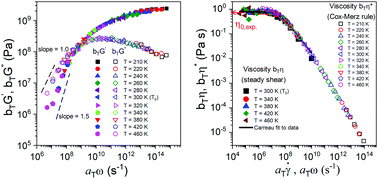Extending the timescale of molecular simulations by using time–temperature superposition: rheology of ionic liquids†
Abstract
Molecular dynamics simulations are used to determine the temperature dependence of the dynamic and rheological properties of a model imidazolium-based ionic liquid (IL). The simulation results for the volumetric properties of the IL are in good agreement with the experimental results. The temperature dependence of the diffusion coefficient of anions and cations follows the Vogel–Fulcher–Tammann equation over the range of the temperatures studied. The shear viscosity of the IL shows a Newtonian plateau at low shear rates and shear-thinning behavior at high shear rates. The dynamic modulus values indicate that the IL behaves like a viscous liquid at high temperatures and low frequencies, while its viscoelastic response becomes similar to that of an elastic solid at low temperatures and high frequencies. Using the time–temperature superposition (TTS) principle, the dynamic moduli, shear viscosity, and mean squared displacement of cations and anions in the diffusive regime can be collapsed onto master curves by applying a single set of shift factors. Due to the large mismatch in the timescale investigated by the atomistically detailed simulations and experiments, the glass transition temperature predicted in simulations shifts to higher values. When this timescale mismatch is accounted for by using appropriate shift factors, the master curves of the dynamic moduli obtained in simulations closely match those obtained in experiments. This result demonstrates the exciting ability of TTS to overcome the large timescale disparity between simulations and experiments which will enable the use of molecular simulations for quantitatively predicting the rheological property values at frequencies of practical interest.



 Please wait while we load your content...
Please wait while we load your content...